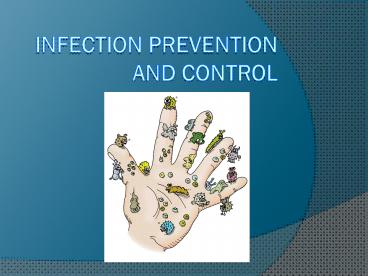INFECTION%20PREVENTION%20AND%20CONTROL - PowerPoint PPT Presentation
Title:
INFECTION%20PREVENTION%20AND%20CONTROL
Description:
... food, medical equipment) Pathogens need a proper environment to survive (food, oxygen ... Clinical Appearance Lab Data Lab ... HAND HYGIENE (HCP, PATIENT ... – PowerPoint PPT presentation
Number of Views:220
Avg rating:3.0/5.0
Title: INFECTION%20PREVENTION%20AND%20CONTROL
1
INFECTION PREVENTION AND CONTROL
2
SCIENTIFIC KNOWLEDGE BASE
- ENTRY AND MULTIPLICATION OF ORGANISM RESULTS IN
DISEASE - COLONIZATION OCCURS WHEN A MICROORGANISM INVADES
THE HOST BUT DOES NOT CAUSE INFECTION (INJURY TO
CELLS) - PATIENT SAFETY ISSUE
3
CHAIN OF INFECTION
- Infectious agent or pathogen
- Reservoir
- Portal of exit
- Mode of transmission
- Portal of entry
- Susceptible host
4
Infectious Agent/Pathogen
- Microorganisms (bacteria, viruses, fungi,
protozoa - Normal flora
- Colonization
- Virulence
- Susceptibility
- Review Potter Perry Table 34-1 (pg. 643) Common
Pathogens
5
Reservior
- Animate sources (humans, animals, insects)
- Inanimate sources (soil, water, food, medical
equipment) - Pathogens need a proper environment to survive
(food, oxygen, water, temperature, pH, light) - Carriers
- Toxins (Exotoxins, endotoxins)
6
Portal of Exit/Entry
- Skin and Mucous Membranes
- Respiratory Tract
- Urinary Tract
- Gastrointestinal tract
- Reproductive Tract
- Blood
7
Modes of Transmission
- Contact (Direct Indirect)
- Droplet
- Airborne
- Vehicles
- Vectors
8
Susceptible Host
- Susceptibility (Resistance to infection)
- Factors which influence susceptible
- Age
- Nutritional status
- Chronic disease history
- Trauma
- Smoking
9
The Infectious Process
- Incubation Period
- Prodromal Stage
- Illness Stage
- Convalescence
- Pathogenicity of organism
- Localized vs. systemic
10
DEFENSES AGAINST INFECTION
- Normal flora
- Body System Defenses (PP Pg.647)
- Inflammation
- VASCULAR AND CELLULAR RESPONSE
- EDEMA
- PHAGOCYTOSIS
- LEUKOCYTOSIS
- INFLAMMATORY EXUDATE
- SEROUS
- SANGUINOUS
- PURULENT
11
SPECIFIC DEFENSES AGAINST INFECTION
- CELL- MEDIATED IMMUNITY
- ANTIBODY-MEDIATED IMMUNITY
12
HEALTH CARE ASSOCIATED INFECTION (NOSOCOMIAL)
- Infections that are a result of health care
delivery, not present at admission - EXOGENOUS
- ENDOGENOUS
- IATROGENIC
- Refer to Potter Perry Table 34-2 Pg. 648 (Sites
for Causes of HAIs)
13
Common Health-Care Associated Infections
- Urinary Tract Infection
- Surgical/Traumatic Wound Infection
- Respiratory Tract
- Bloodstream
14
The Nursing Process Infection Control
(Assessment)
- Status of defense mechanisms
- Client Susceptibility
- Nutritional Status
- Stress
- Disease Process
- Medical Therapy
- Clinical Appearance
- Lab Data
15
Lab Data
- WBC Count
- Sedimentation Rate
- Cultures of sputum, urine, blood
- Differential Count
16
Assessing Risk for Infection
- Age
- Disease Processes
- Lifestyle
- Occupation
- Diagnostic Procedures
- Medications
- Travel History
- Nutritional Status
17
NURSING DIAGNOSIS AND PLANNING
- NANDA APPROVED DIAGNOSIS
- GOALS AND OUTCOMES
- MEASURABLE
- REALISTIC
- PRIORITIES
18
Acute Care Interventions
- MEDICAL AND SURGICAL ASEPSIS
- CONTROL/ELIMINATION OF INFECTIOUS AGENTS
- CONTROL/ELIMINATION OF
- MODES OF TRANSMISSION
- PORTALS OF ENTRY
- RESERVOIRS
- HAND HYGIENE (HCP, PATIENT, FAMILY)
19
INTERVENTIONS
- ISOLATION PRECAUTIONS
- HYPERTHERMIA INTERVENTION
- ELIMINATE UNDERLYING CAUSE
- FEVER MANAGEMENT
- HEALTH TEACHING
- ANTIBIOTIC THERAPY
- PSYCHOSOCIAL SUPPORT
- HEALTH CARE RESOURCES
20
Isolation Precautions
- CDC and OSHA Guidelines
- Contact
- Droplet
- Airborne
21
Drug Resistant Organism Infections Colonizations
- Methicillin-Resistant Staphylocuccus aureus
(MRSA) - Vancomycin-Resistant Enterococcus (VRE)
- Extended-Spectrum Beta Lactamase (ESBL)
- Multi-drug Resistant Tuberculosis
22
Personal Protective Equipment
- Gowns
- Respiratory Masks
- Eye Protection
- Gloves
- Specimen Collection
- Bagging Trash Linen
- Transporting Patients
23
EVALUATION
- MEASURE SUCCESS OF INFECTION CONTROL TECHNIQUES
- COMPARE PATIENTS RESPONSE TO ACTUAL OUTCOME
- WHAT WILL YOU DO IF GOAL/OUTCOMES NOT ACHIEVED?






























